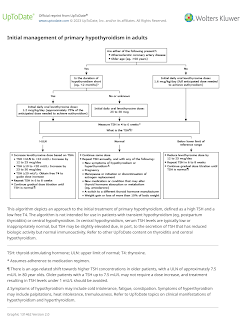Levothyroxine
Introduction
Levothyroxine is classified as a narrow therapeutic index drug.
- Therapeutic drug monitoring based on serum Thyroid Stimulating Hormone (TSH) and total or free-levothyroxine levels is routinely employed to facilitate levothyroxine dose titration.
- The goal is to achieve a satisfactory balance between maximizing efficacy and minimizing serious dose-related toxicity.
- Over-replacement and under-replacement of thyroid hormone can increase cardiovascular risk.
To ensure safe maintenance of thyroid hormone levels, authorities are adopting stricter potency specifications for L-T4, the most stringent of these being 95-105% of the labelled dose over the whole shelf-life.
Dosing in Hypothyroidism
The dosage of levothyroxine is individualized based on clinical response and serum thyroid stimulating hormone (TSH) and/or free T4 concentrations.
- Individual T4 requirements correlate better with lean body weight than total body weight.
- Adjust the levothyroxine dose at 4- to 8-weekly intervals to achieve a serum TSH concentration in an age-specific target range.
- The target for serum TSH concentration is 0.5-2.5 milliunits/L for patients younger than 60 years old, and 1-5 milliunits/L for patients 60 years and older.
- The average maintenance dose is ~1.6 mcg/kg/day, but the required doses can vary widely, ranging from 50 to ≥200 mcg/day.
- Maintenance doses >300 mcg/day are rarely required; in patients who require high doses (e.g., >2 mcg/kg/day), consider missed doses, malabsorption, and/or drug interactions.
NOTE: Although symptoms may begin to resolve after 2-3 weeks, steady-state TSH concentrations are not achieved for at least 6 weeks. Serum thyroid hormone concentrations increase first and then TSH secretion begins to fall because of the negative feedback action of T4 on the pituitary and hypothalamus.
Brand Switching
A consistent preparation (i.e. the same formulation and manufacturer) is preferred to minimize variability form refill to refill.
- If switch in brand occurs, TSH laboratory values should be monitored post switch to ensure that levels remain consistent with appropriate treatment.
- There have been 177 adverse events reported related to brand switching.
Administration
Levothyroxine should be taken with water consistently at least 30-60 minutes before breakfast or at bedtime (at least 3-4 hours after the last meal) for consistent absorption.
Do not administer within 4 hours of calcium- or iron-containing products.
Storage
DISCLAIMER: The following information is not intended as a practice update, but as an observation for discussion.
In Malaysia, levothyroxine is not stored inside refrigerator, as local product leaflet recommends storage at room temperature.
However, in Australia, the Therapeutic Goods Administration instructed Sigma Pharmaceuticals in June 2003 to reduce the shelves life of levothyroxine from 24 months 12 months (with refrigeration). This was in light of evidence that their potency was reduced at the end of their shelf life.
- Both Eutroxsig and Oroxine are required to be stored at 2°C to 8°C due to stability concern. Laboratory tests have shown that if not stored correctly, there is a reduction in potency of the active ingredient levothyroxine sodium. A single blister strip can be removed from the carton and stored below 25°C for up to 14 days (2 weeks).
- Levothyroxine brand Eltroxin and Levoxine does not need refrigeration, but is essential to be kept under 25°C.
It is worth noting that Australia appears to be the only country where levothyroxine tablets require refrigeration.

Comments
Post a Comment